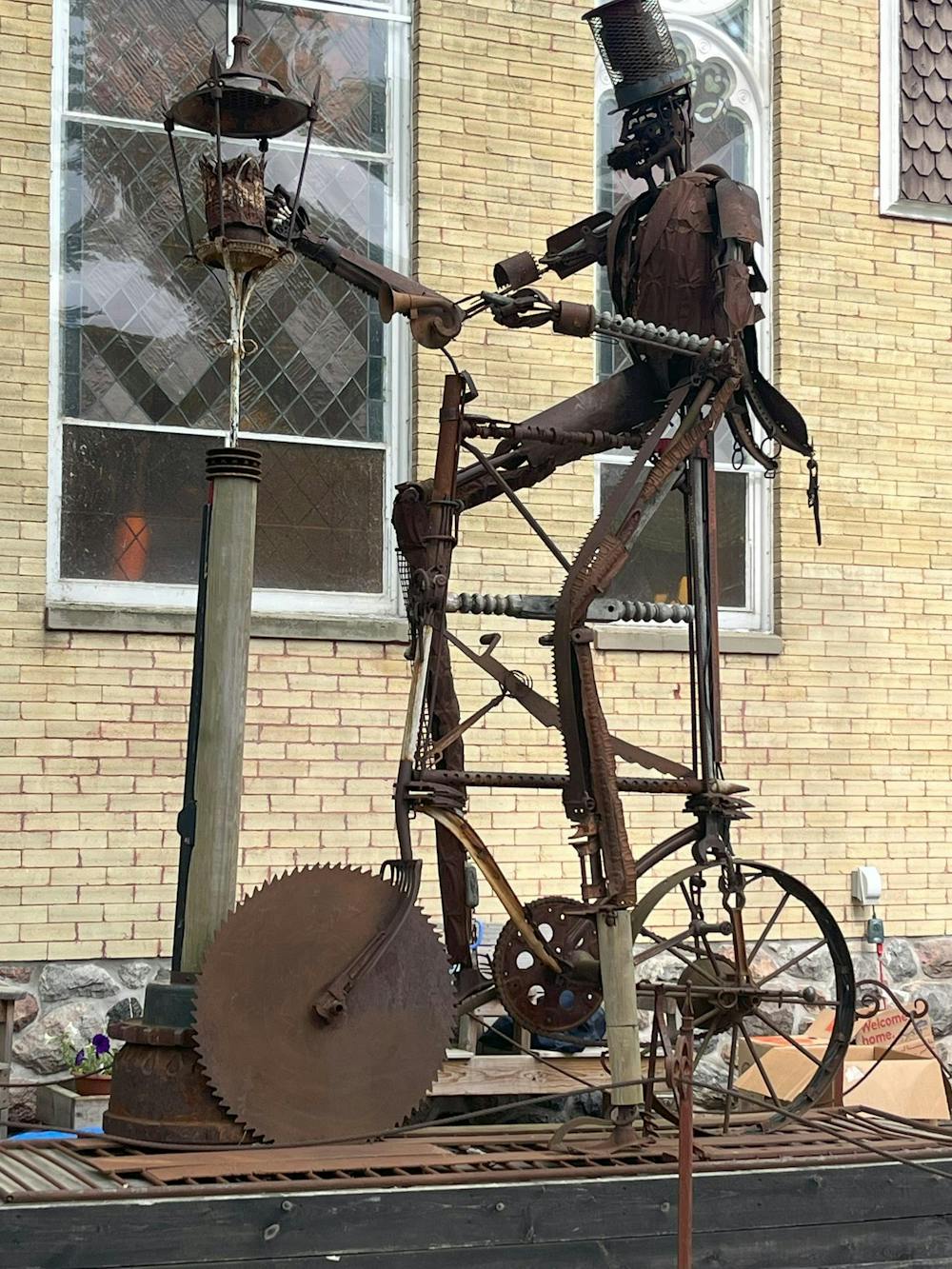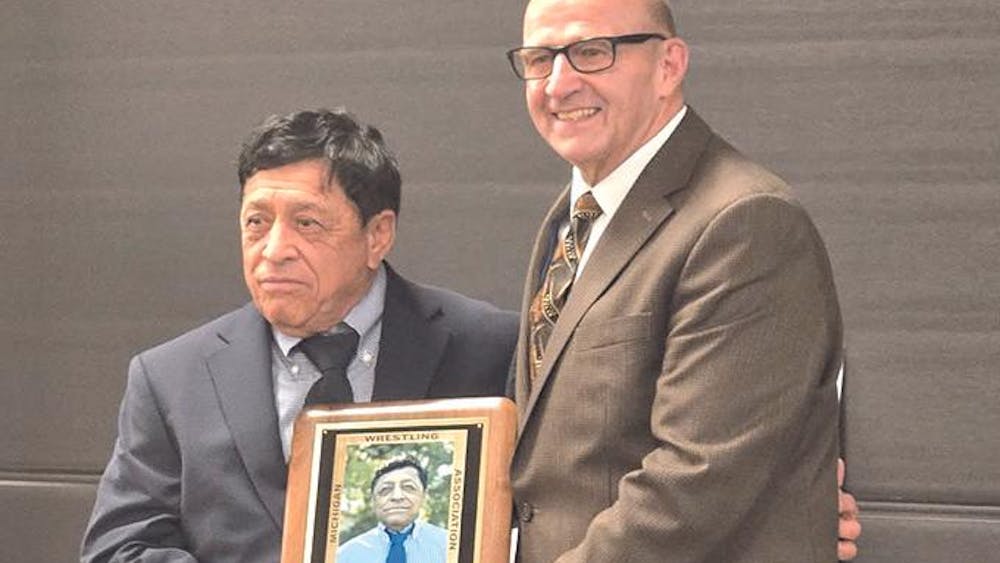Historical art, like historical fiction, tells a story based on facts from the past but expressed from the imagination and in the unique style of the artist or author. Such is the case of the metal sculpture by artists Tyler and Ashley Voorhees called “The Lamplighter,” which is being dedicated on Sunday, June 29, at 4 p.m., at the Pentwater Historical Museum, 85 S. Rutledge St., in Pentwater. No tickets are needed to attend. Limited seating and standing room will be available, with light refreshments following the ceremony. Information about the museum expansion plans will be shared.
Originally brought to Pentwater by the Pentwater Arts Council (PAC) as part of their 2024-2025 Sculpture Walk, “The Lamplighter” has been purchased and donated to the museum by David and Carol Messerlie, longtime seasonal residents of Pentwater.

“In addition to stimulating discussions about art, our purpose with the Sculpture Walk was to enhance the community by using art to call attention to important locations and events in the village. As a result of our three Sculpture Walk events, we have been able to provide six permanent installations of sculptures at the library, the town hall, the channel, our main street shopping district, the municipal marina and now the museum. It is wonderful how the historic significance of ‘The Lamplighter’ relates to its permanent home at the museum,” PAC President Judy Pazol shared.
Tyler Voorhees has always been fascinated by jobs in the past that have laid the foundation for jobs in the present. His hundreds of paintings and his large wall murals fall under the umbrella theme of “Jobs of Yesteryear.” As modern expressions of the past, his art “combines history and surrealism to tell the stories of absolute jobs.” His murals have found homes in the U.S., Morocco, Mexico, and Belgium, where Voorhees explains, “They aspire to tell the unique stories of each community’s jobs and how the community’s workers have shaped their cities, towns, and villages.”
Voorhees spends significant time researching his subjects prior to creating his art. He found that lamplighters were ordinary citizens who were paid to light the streetlamps in the evening and extinguish the lamps in the morning in order to conserve the oil in the lamps. The earliest lamps used whale oil. Replenishing the oil and installing new wicks were part of the lamplighter’s job before gas and electricity eventually replaced the lamplighter’s work. Ladders, poles and tall bikes enabled the lamplighters to reach the lamps. The lamplighters were important to the community because their work enabled residents to safely use the streets after dark.
Although the sculpture of the lamplighter ties into an extensive collection of paintings and murals about lamplighters, the sculpture was a unique medium for Voorhees driven by unique circumstances. Voorhees sold his art through his website and at craft fairs in large cities until Covid put a temporary end to craft fairs and forced him to stay at home. He and his wife Ashley, a graphic artist, wondered what alternative project they might tackle in the face of Covid. They decided to try something new for them: a larger-than-life sculpture. It required learning how to weld and acquiring the necessary equipment.
With paint they sketched a lamplighter on a tall bike on the floor of their two-story garage. But the tedious, piece-by-piece construction took place outdoors, where their neighbors watched the progress of the project with curiosity and great interest. Living in a small, rural community, the couple had access to a wide variety of tools and antique farm implements. The neighbors were more than happy to contribute from their collections and took delight in seeing how their contributions were incorporated into the sculpture. Ashley said, “We found the face and the hands to be the most challenging to create. We envisioned the project might take a few weeks to accomplish, but we were surprised to see it took us eight months!” Tyler added, “It became a real community project, and every piece came with a story of whose it had been and how it had been used. When it was finished and we had to load it up for transportation, I engaged a group of local guys with muscle to help with the task.”
The Voorhees family has an interesting history of its own. Both Tyler and Ashley grew up in rural South Dakota. Tyler was one of nine students in his high school graduating class. Following their college years, they spent two years in Germany to work, to travel, and to soak in Europe’s rich history. Upon their return to the U.S. in 2010, Tyler Voorhees taught second grade. In 2015, the couple took their family to the road, traveling over 17,000 miles between art fairs. Through the years, Voorhees continued to refine his unique style of elongated figures and objects. In 2017 they settled their family of four in a small village outside of Saugatuck in SW Michigan to operate their art business from home. They love the natural setting of their home and the quiet, rural life.

Reflecting on life in West Michigan, Voorhees drew a comparison between the lamplighters of yesteryear and lighthouse keepers in the Great Lakes. Both were “keepers of the light,” a theme close to his heart. Ashley Voorhees shared that the sculpture of “The Lamplighter” lights up at night from within.
They look forward to their visit to Pentwater later this month for the dedication of their sculpture here. Following the ceremony, they will be guests at a special dinner where they will have the opportunity to meet David and Carol Messerlie, whose gift has made “The Lamplighter” sculpture a permanent fixture in Pentwater.













